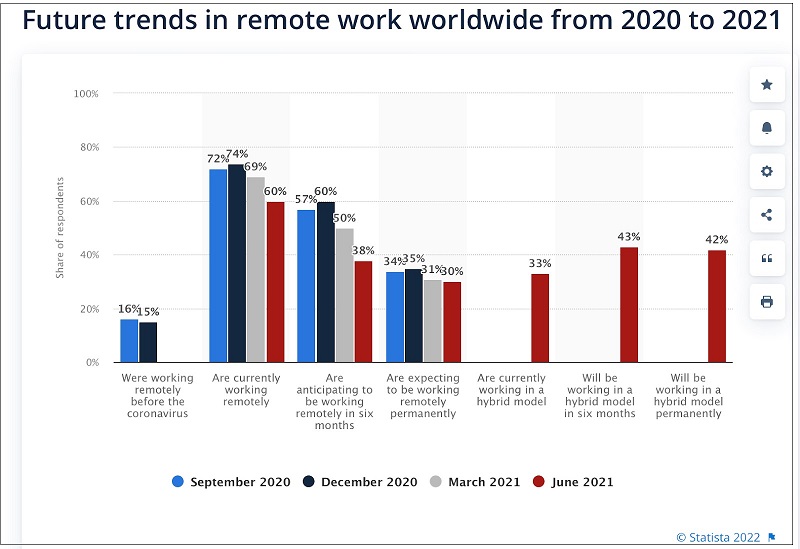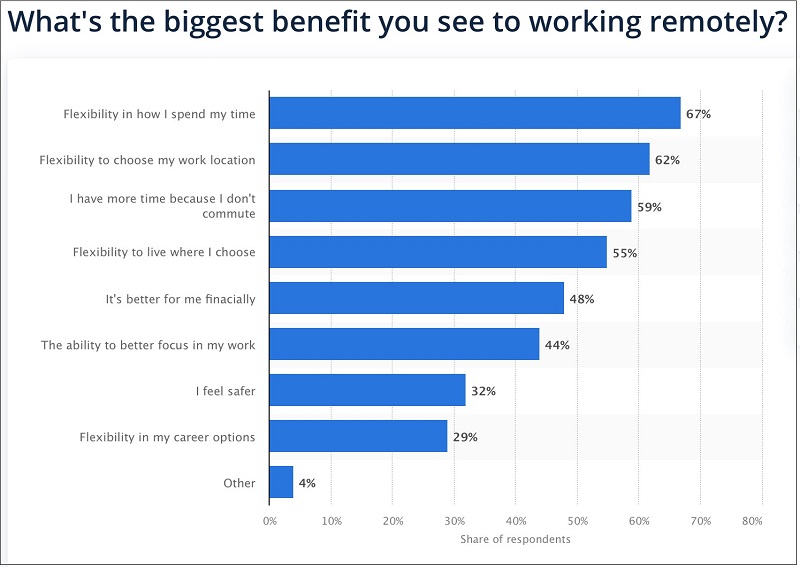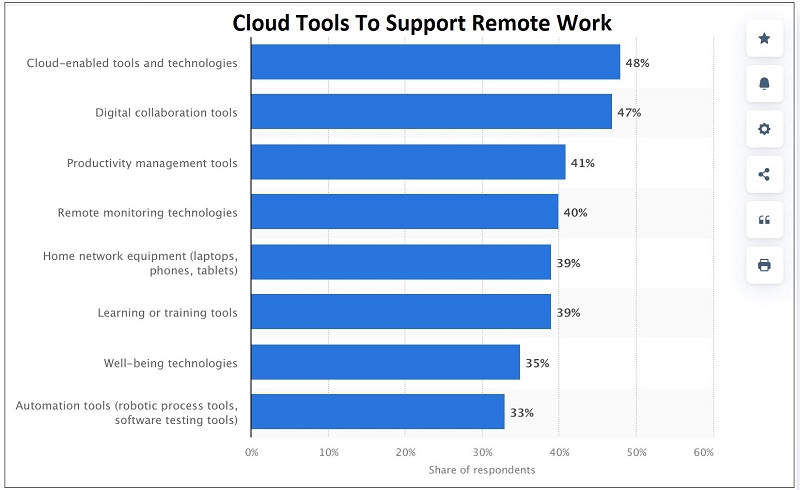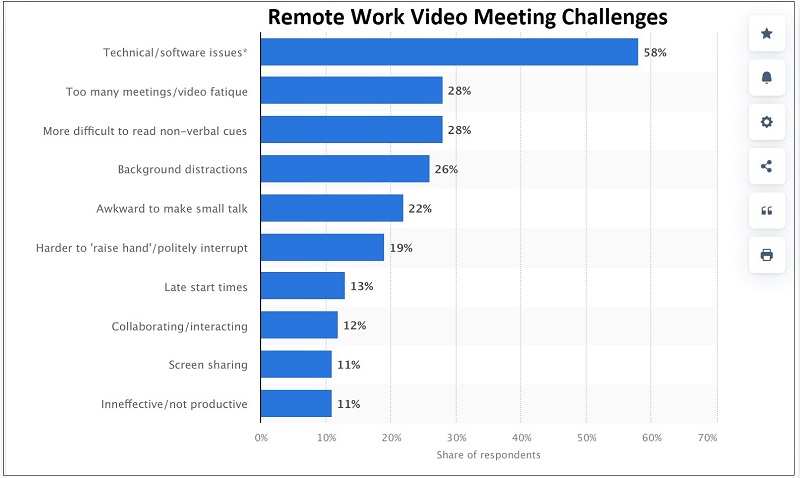As the world becomes more and more global, it’s becoming more common for teams to operate across different locations. Developments in virtual meeting technology has also made it easier for teams to work in a remote or hybrid workplace.
Remote working is a term that can be applied to any team that works outside of a central office space. Typically, it refers to a team that works in the same geographic area, but mainly working from home instead of accessing a full-time office.
However, working remotely is now possible internationally. Some teams operate across different time zones, particularly in multinational corporations (MNCs) with offices all over the world.

Source: Statista.com
Global working: benefits and drawbacks
Working across different time zones doesn’t always mean working across national borders. In the USA, for example, there are six time zones. Australia has nine. Russia has eleven. Team members may be just one hour apart, or up to thirteen.
Time differences have different degrees of positive and negative side effects, depending on the number of time zones involved and the size of the time difference. These are some of the major pros and cons of working across different time zones in a team.
Benefits
The ability to work across different time zones is an exciting reflection of the technology that we now have. These are some of the most beneficial aspects of working across as part of a global team:
- New perspectives: teams working globally can bring in new perspectives, personally and professionally, and be innovative with new ways of working.
- Flexibility: remote working requires a degree of flexibility which can allow your team to work when and where suits them and ultimately increase productivity.
- Use of new technology: working globally is a great opportunity to introduce new technologies into your team and gain new employability skills.
Keep these in mind when planning to make the most of your global working strategy and creating a collaborative workspace.

Source: Statista.com
Drawbacks
Working across different time zones can bring challenges. These are some of the most common that you might face.
- Timings: large time differences can bring portions of the day where you aren’t working at the same time and may not be able to get hold of someone or host a meeting when you want.
- Delays: if you send an email at 9am your time, you may have to wait a while for a response, so you’ll need to plan carefully if you need urgent information.
- Team disconnection: your team may start to feel disconnected from one another if there are only short windows when everyone is working at once.
These challenges can be difficult but can usually be managed with careful planning and mutual understanding in your team.
10 tips for working in different time zones
Managing the difficulties of working across different time zones can be difficult but rewarding. It’s completely possible to run a productive and cohesive team while managing time differences. In fact, doing this can provide opportunities for your colleagues to be innovative and flexible.
1. Be flexible
Being flexible is very important to succeeding in working across different time zones. This is particularly true where there is a large time difference between crucial points in your team.
You’ll need to be flexible on deadlines and meeting times as far as possible, in order to accommodate the working hours of every person in your team. For example, if one team member is in the UK and another in China, there will be an 8 hour time difference. Both colleagues may need to be open to meeting outside of traditional working hours when needed to maintain productivity and team cohesion.
Another outlet of flexibility that may be helpful to remote teams is not to fear new technologies. Implementing new processes to make certain processes automated or less labor-intensive can make it easier to work in staggered periods and at times when some team members are unavailable. Using an orchestration platform to organize your new processes and integrate them into existing ones is one of many ways to successfully introduce new technology into your business.
2. Keep a schedule
Keeping on top of appointments is crucial. Global remote working often means that colleagues will have different core working hours, so you’ll need to keep track of when each colleague is working.
This schedule should be centrally accessible and be used to track standing meetings so that other work can be planned around it.
3. Make use of the cloud
The cloud is a great tool for remote working teams. Cloud storage solutions enable teams to purchase applications that they need and adapt them to individual circumstances. Your team can store documents and databases in the cloud securely whilst still being able to share them between colleagues.
Once set up, the cloud is less reliant on IT teams and on-site hardware than traditional storage, so it’s great for remote teams that don’t all share the same working hours.
For example, a customer service team might look into the best customer service software to use for remote teams. This team may need access to customer data and working process instructions at all times of day, so a cloud solution is likely to work better for them than traditional data storage methods.

Source: Statista.com
4. Understand time zones
It’s a small but important consideration to actually understand the time zones that your team is working across and how they differ from your own.
Things to consider include:
- How many time zones your team works across
- What are the time differences?
- What are their working hours in your time?
- Are there regional working hour differences in their location?
This is a small step that your team can take to avoid issues in the future and to get their work done with plenty of breathing room.
5. Set boundaries
There’s a fine line between flexibility and a lack of boundaries. Encourage your team to set boundaries as to when they are able to work in line with traditional working hours.
If, for example, your colleague in another time zone is comfortable having meetings late in the afternoon or evening to accommodate your working hours, be sure to set a limit on when they’re happy to do this. 4pm for you might be 10pm for them, so be sure to set time-related boundaries. Perhaps limit all meetings to before 7pm for all colleagues.
6. Stick to what is necessary
Arranging meetings over large time differences can be difficult and require a lot of confirmations. Stick to what is strictly necessary in terms of frequent meetings and try to keep them as short as possible.
If a piece of information can be communicated clearly in an email, try to put it in an email instead of requesting a call. If it’s possible, keep important information for your next scheduled meeting instead of hosting an impromptu one.
7. Have a communications strategy in place
Communication is the key to successful working across different time zones. There are many virtual meeting challenges that can make collaboration difficult, especially across teams working in different time zones.

Source: Statista
You should have a business communication guide in place to standardize the communications across your team and make sure that your colleagues get the information that they need.
For example, if you’re working with a shared spreadsheet or database, try to set out guidelines for uploading and sharing data so that team members don’t have to chase information when they pick up the work later. The guide should also set out escalation protocols and a clear chain of command when it comes to accessing information and working processes.
8. Be fair and accessible
You need to be as fair as possible when arranging scheduled meetings and assigning work. The onus should not always fall on one person or team to work outside of their core hours.
For example, if a team is split across two locations with an eight hour difference, their manager could alternate meetings so that one team starts work early, and then the other finishes late the next time.
9. Use visuals
It’s important that your team understands what time it is in all of your working locations. Using a graphic representation of different time zones and the time differences between central offices or working locations can help your team to quickly work out what time it is where their colleagues are.

Source: Image generated by writer
Try to have these up in central offices. If your team works completely remotely, make sure to send a chart or link to your colleagues to make this calculation easier and ready to hand.
10. Don’t fear experimentation
Experimentation is the start of innovation. Working remotely across different time zones can cause genuine cohesion issues in your team and a falling off in productivity. Getting around this requires a high level of innovation in your working processes and relationships.
Speak with your team to understand what they need and then start experimenting. Introduce new technology and processes to help track schedules and assign work. If something isn’t working, don’t be afraid to alter or discard it in favor of something new.
Ensuring success
The number one factor to succeeding as a global team across different time zones is to have a plan. A remote-working strategy is vital to your team understanding what is expected of them and how they can achieve it.
You should all have a detailed understanding of one another’s boundaries and availability windows. Further to this, you should have regular opportunities for discussion to make sure that your workflow is running smoothly.
If you are interested in learning more about remote work, check out the different ways we can help through our workspace solutions.
Guest Author Bio: Jessica Day – Senior Director, Marketing Strategy, Dialpad
Jessica Day is the Senior Director for Marketing Strategy at Dialpad, a modern SaaS contact center platform that takes every kind of conversation to the next level—turning conversations into opportunities. Jessica is an expert in collaborating with multifunctional teams to execute and optimize marketing efforts, for both company and client campaigns. Jessica Day also published articles for domains such as Recruitee and VirtualSpeech. Learn more about Dialpad here.
